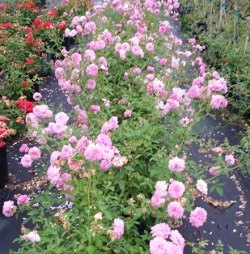S & J Nursery’s Guide to Growing
Caldwell Pink / Pink Pet Rose
for the Northeast Florida Jacksonville | St. Augustine area Landscape
Caldwell Pink/ Pink Pet Rose  Origins:
Origins:
– Ok so I’m going to attempt to explain why I have kept both names on this
rose, bear with me it can get complicated.
Caldwell Pink / Pink Pet Rose is an Old Garden Rose. That means it was in existence prior to 1867, which is the year the first Hybrid Tea rose “LA FRANCE” was introduced. These Old Garden Roses can be species roses ( species rose = a rose in its natural state untouched and unedited or
hybridized by humans and found growing in various locations across the planet, there are many species roses, the native Cherokee rose is the most common one in the North Florida area ), or they can be “found” roses (“found rose” = a rose found growing on old home garden sites and rescued or brought back into cultivation to be planted in our modern rose gardens and landscapes)
Caldwell Pink / Pink Pet Rose is a “found” rose. It was given the name Caldwell Pink after the location where it was found growing in Texas, as is frequently the case with “found” old garden roses, we have to call it something until the experts can figure out what it is and where it belongs in
the world of roses. This “found” name is referred to as its study name. Can you guess why? Yep those experts get to work and study it, if its already in known existence to the world of roses then the study name reverts back to the registered name. If no identification is ever found then the rose gets registered with its “found” name. End of story.
Well Caldwell Pink is one of these roses, except there is debate among the
authorities in the rose World as some experts believe this to be the China Rose ( china’s are one of many sub classifications of Old Garden Rose’s ) registered as Pink Pet. Most often I find it listed as an Old Garden or Antique Polyantha rose Caldwell Pink in rose books and internet listings etc.
To add insult to injury, not only is its name in question but its growth habit is debated as well. It seems if you ask 10 people you will get 10 answers. Some rosarians state that there is a sport (sport = naturally occurring genetic mutation resulting in very similar characteristics but neither flowers of another color or a different growth habit , leaf change etc) of this rose
that will vine up to 12 ft and only blooms once in the spring that looks identical, so you wouldn’t really know what you bought if you just came across a unnamed rose in a garden center like I did. Other information
never mentions a vining version of this pretty pink cluster rose but all will mention its tendency towards vining and that it can easily be maintained as a small shrub with a little pruning. I did try to figure it out and stopped trimming mine for a season and let the runners grow, it quickly turned into a non blooming viney thing, the runners grew quickly, rambling to almost 6 ft away from the center in just one growing season here in the North Florida area. bored of it quickly knowing all the roses I was miss sing by not whacking it back once a season, so that little experiment to see if left alone the same rose that has been a low shrub for so many years in my garden would grow to 12 ft quickly got canned. We may just never know, maybe someday I will run across a named Caldwell Pink / Pink Pet Rose climber and be able to plant it.
I kept both names because if the experts cant figure it out then I certainly cant! And frankly I just don’t care. Name, no name, two names, shrub or vining rose this little pink rose holds a special place in my heart. It was the first rose I bought for my garden. They are hard to resist when you come across one in full bloom, the delicately small pink blooms form in clusters and one stem looks just perfect in a bud vase. I bought it at a local Ace Hardware in a one gallon container, unnamed of coarse, and spent the next few years trying to figure out what it was and buying every one I could find. I knew nothing about roses and treated it like every other perennial in my North Florida garden, when it looks bad cut it back to nothing and watch it regrow!
Well this little Caldwell Pink / Pink Pet Rose thrived, every time it set new blooms it etched its no name self a little deeper into my gardens heart. I have now grown this rose for 15 years at 5 different houses in the North Florid area and it performs every time. My roses never get to much more than 2-3 ft before I am pruning again for a rebloom, and rebloom they will. Its quite a stunning display of clusters of 7+ small pink blooms on a hardy rose and full green foliage with never a black spot in site. And in our North Florida / Jacksonville / St. Augustine area gardens that’s saying something!!!
Caldwell Pink / Pink Pet Rose Preferred Exposure:
– Full sun, roses will need 6-8 hours of direct sunlight to bloom and perform
best in the North Florida/ Jacksonville / St. Augustine area.
Caldwell Pink / Pink Pet Rose Soil Preference / Salt tolerance:
– Plant Caldwell Pink / Pink Pet Rose roses in North Florida in just about any well draining soil. Add a healthy shovel full of compost or cow manure to the planting hole when you dig and you’ll love the extra help it gives you as you establish the rose in your gardens landscape.
Caldwell Pink / Pink Pet Rose Size Variance:
– Caldwell Pink / Pink Pet Rose will quickly reach 2-3 ft high and 2-3 ft wide
in the North Florida | Jacksonville | St. Augustine garden area. The vining sport is said to grow to 12 ft if you happen to run across it for sale.
Caldwell Pink / Pink Pet Rose Growth Habit:
– Rounded rambling habit rose as wide as it is high, trim back blooms as
they decline and fertilize at least once a season for best blooming.
Caldwell Pink / Pink Pet Rose Growth Rate:
– Extremely quick to establish itself in the landscape and reaches mature size within the first growing season from a three gallon plant on the next growing season from a one gallon size plant.
Caldwell Pink / Pink Pet Rose Bloom:
– This rose will form clusters of smaller approximately 1 1/2 ” blooms
in abundance in late spring summer and fall in the North Florida landscape, don’t forget to give it a hard trim when the blooms begin to decline, don’t wait for this rose to have no blooms on it, it just wont happen,
trim it back when most of the blossoms have seen better days and it will rebloom within just a few weeks with a stunning display all over again.
Caldwell Pink / Pink Pet Rose Water Requirements:
– Water daily to establish into the landscape and use supplemental irrigation twice a week after that for best results in the landscape when not receiving regular rainfall.
Butterfly or Bird Attracting:
Best Uses For Caldwell Pink / Pink Pet Rose :
– Excellent when planted as a single specimen in a perennial border for a cottage garden appearance or when planted in masses for maximum landscape curb appeal. Roses also make great container plants in Florida, Great for planters at the entryway of your home or next to the back porch or patio for an easy care long blooming accent.
Care of Caldwell Pink / Pink Pet Rose :
– Caldwell Pink / Pink Pet Roses can certainly be treated like a fussy hybrid
tea rose, but why bother? These hardy little own root roses grow with just the minimal maintenance of a seasonal pruning and fertilizing. I Trim mine back pretty hard removing old canes or crossing canes and pruning down to 12-14 inches high each spring and again in summer and a final time in the fall, usually just removing the spent blooms in fall, if I even bother to get around to it. And they perform spectacularly.
– Amend the planting hole well with compost or composted cow manure when installing roses into the landscape.
– Water every day during the establishment period. See watering your newly planted items for more information.
– They will need good water during the establishment period and bi-weekly
supplemental irrigation particularly in periods of low rainfall.
– Add compost or cow manure yearly as a surface treatment pulling back the mulch and spreading it around under the foliage of the plant on top of the existing soil. don’t forget to remulch around the plants to help them stay cool and help them to retain moisture in our hot sunny North Florida
gardens.
– Plants respond well to a mixture of rose food and Milorganite each spring and  again in mid summer, sprinkling the fertilizer around the mulch circle underneath the foliage of the plant. Basically I fertilize mine at each trimming.
again in mid summer, sprinkling the fertilizer around the mulch circle underneath the foliage of the plant. Basically I fertilize mine at each trimming.

